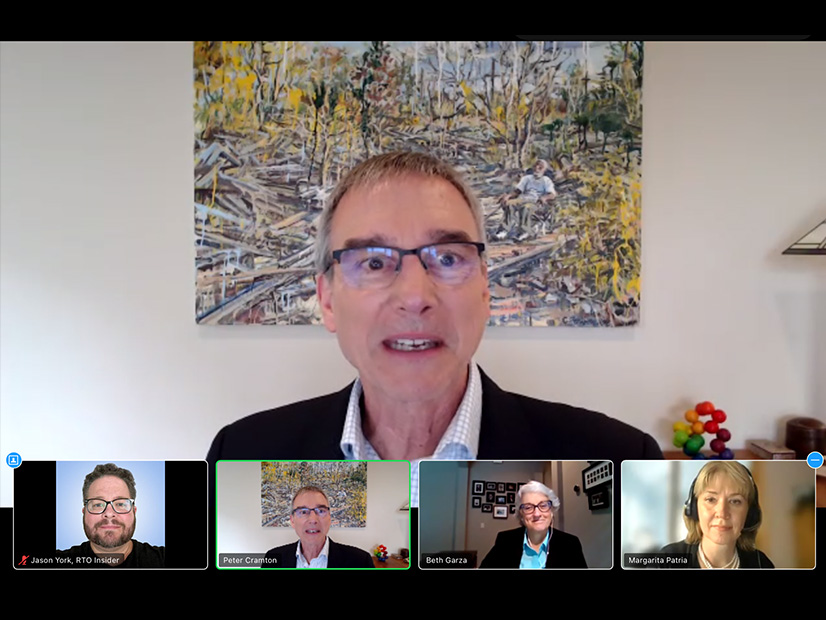Beth Garza and Peter Cramton have unique insight into the extreme weather event that affected Texas in mid-February. A winter storm, followed by historically low temperatures, plunged the state into an energy crisis. It then grew into a natural gas market disaster punctuated by financial tumult, political turmoil and scapegoating renewable energy resources.
Garza and Cramton spoke Wednesday during a Northeast Energy and Commerce Association webinar, “Lessons Learned from Texas,” that focused on the calamitous weather event.
Garza, director of ERCOT’s Independent Market Monitor from 2014 to 2019 and now a senior fellow on electricity policy for R Street Institute, still lives in Austin and did not have electricity for 81 hours. She said that ERCOT went from serving record winter peak demand on the evening of Feb. 14 to shedding 10 GW of firm load six hours later.

Former ERCOT Director Peter Cramton addresses a NECA webinar. | NECA
“The magnitude of curtailment was just huge, and that played into the effects of this event being so large,” Garza said. “Just to compare, the amount of load shed was probably about 30% of expected demand … for almost three days.”
Garza said the last time that “any kind of curtailment of firm demand” occurred was 2011 during another winter storm, but that was “6 to 8% of expected demand,” and the total curtailment period was about four hours.
One thing she said she is learning from this is that “every good crisis has to start with blaming someone.” She said all forms of generation were affected “in some respect,” with the loss of almost half of ERCOT’s natural gas-fired generation the most significant portion of it. Power was cut to gas infrastructure not listed as critical load.
Garza added that the increased codependence of electricity and natural gas systems is a “dysfunctional relationship framework.”
“Two industries are absolutely reliant on each other. They do not work well together and are not well coordinated,” she said.
It is also hard to deal with the present repercussions and future changes when the Public Utility Commission of Texas and ERCOT were “basically decapitated” in the aftermath of the storm.
The PUC saw all three of its commissioners resign amid the finger pointing. Two replacements were finally appointed last month and held their first open meeting last week. (See ERCOT Board Chooses Jones as Interim CEO.)
The ERCOT market faces a more than $3 billion shortfall after short-term electricity prices reached the $9,000/MWh cap during widespread generator outages. Brazos Electric Power Cooperative, which declared bankruptcy on March 1, accounts for more than half of that total, owing $1.86 billion. Rayburn Country Electric Cooperative, another troubled publicly owned utility, is short $570.4 million. (See Is the ERCOT ‘Casino’ Going Bust?)
“If you were to ask me who made money in this event, my flippant answer is the natural gas companies made money, and lawyers are going to make money going forward,” Garza said. “I won’t dwell on any of the specifics. Just know that it’s a mess and will be a mess. Sorting these things out will take years to accomplish.”
Fixing Communication
Cramton had served on ERCOT’s board as an independent director since 2015 and was elected its vice chair in the days leading up to the storm. An economics professor at the University of Cologne and the University of Maryland College Park, he has researched auctions and market design for 37 years, focusing on complex markets. He has advised many governments on market design and dozens of bidders in major auctions.
So, what is the first thing Cramton wants to fix ahead of the next extreme weather event? Communication.
“That can be fixed at very low cost,” Cramton said.
Cramton said there was a lack of effective communication from Gov. Greg Abbott in advance of the storm “to prepare people to take actions for an event that was entirely foreseeable.”
“The governor was instructed on Saturday that significant load would be shed,” Cramton said. “We didn’t know the exact quantity, but at that point, he should be talking about how to prepare for a winter storm because many Texans are not familiar with extreme winter weather.”
Cramton said a strong message from Abbott encouraging people to conserve by turning their thermostats down to 55 degrees would have enabled “more Texans to have power and have their temperature at 55 rather than 10 degrees. There’s a huge difference between 10 and 55 in terms of the amount of destruction.”
“Those kinds of public service messages were missing. Instead, shortly after the outages began, the communications were fingers pointing rather than valuable public service messages,” he said.
Cramton agreed with Garza on the importance of fixing the natural gas market. “One cannot have reliable electricity without a reliable gas supply.”
One thing that Cramton would not fix is ERCOT’s energy-only market. He said capacity markets such as those in ISO-NE or NYISO are like training wheels on a bike. “It can help you learn to ride a bike, but it might not be the best, especially after it goes through the stakeholder process.”
Cramton said ERCOT needs “simpler tools” than a capacity market. His proposal for Texas would be a voluntary forward energy market “so that parties can land in real time in a balanced position that manages the risk as best as it can be managed.”
He concluded that in the long term, more robust interconnection would transform Texas from the legacy energy capital of the country to the future energy capital by exporting “a lot of solar and wind to the rest of the United States. This would help reduce the cost of the energy transition and make the system much more reliable.”


